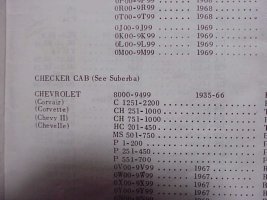The only difference between a trunk key and an ignition key from 1935 through the end of the 1966 model year run, was that the trunk key was pear-shaped, and the ignition key was hexagon-shaped. Now, you will find some OEM keys were made by Briggs & Stratton, and others were made by GM (General Motors). B10 is the standard number for the ignition, and B11 is for the trunk, and sometimes the glove box. Door locks were usually the same as the ignition lock, with the exception of the Cadillac Limousine, which had its own key for the rear right passenger door. This was so the owner of the limo could lock the rear compartment, and the chauffeur couldn't have access to it. The key numbers start with 8000 and end with 9499. These keys had 6 key cuts. Most dealerships had what was known as "try-out" keys, which were a ring of approximately 67 different keys that they could try to find one that would turn the lock cylinder. Once they found the one that would turn the ignition cylinder, they would turn the key to the extreme left, insert a paper clip end into the small hole on the face of the key cylinder to depress the locking mechanism, and continue to turn to the left, until the cylinder came out of the switch. Once out, they would read the 4-digit code on the side of the cylinder, and then the parts department would cut a new key by number. The reason that the try-out keys worked, is because each depth cut was half of the depth cut of a normal key. It would "trick" the lock tumblers enough that the cylinder would turn. Occasionally, you would find a cylinder that none of the keys would work, so then you moved to back up plan B, which was to try a different brand of try-out keys. While I am not a locksmith, I have done my fair share of key cutting by number, and occasionally have re-coded replacement cylinders. Now, in my old age, with very tired eyes, I only do what is necessary for my cars. I still have the books and can provide anyone who would like the cut codes for a particular key. Just keep in mind, that the cut codes may differ across different brands of key cutters. I use Curtis cutters since that was the "official" code key cutter of every GM parts department. The depth codes as shown in the GM service manuals are what Curtis used. Note in the picture below, that it shows the key numbers and the years of application. There is a note in the number book that the try-out keys will work in 98% of the cars up till 1960, and then in only 67% of the cars after 1960. There is no explanation given as to why this is, and I have never been able to get an explanation from anyone in the trade. Many are not even aware of the note in the code book.



